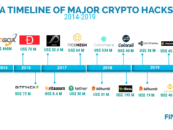
Banks Need to Step Up as Fraudsters Target Surge in Digital Adoption by First Time Users
by Fintech News Singapore February 25, 2021The COVID-19 pandemic has forced organisations and individuals to embrace new practices and move to online channels, bringing with it a significant increase in fraudulent activities.
Affirming this situation, cybersecurity firm Kaspersky recorded a 20% increase in the share of account takeover incidents in 2020 compared to the previous year.
This trend comes on the back of the growing adoption of digital and mobile banking. Boston Consulting Group’s survey of 17,600 respondents last year found that 16% of those surveyed enrolled into online or mobile banking for the first time as a result of the COVID-19 pandemic.
One in three customers used mobile banking more than they did prior to the crisis, and one in four customers is expecting to use physical branches less frequently, or stop visiting altogether once the crisis is resolved.

Sam Bakken, senior product marketing manager at OneSpan
“More people are using digital services, mobile services especially,”
Sam Bakken, Senior Product Marketing Manager at OneSpan, an American cybersecurity technology firm, said during a recent panel discussion.
“Some people had never used these channels before but are using them now. Attackers, fraudsters are looking at [people who are new to the technology] … I think we are going to see attackers realising this and continuing, if not increasing, the investment they make here, especially in mobile.”
The virtual conversation by Fintech News in partnership with OneSpan, featured tech experts from Hong Leong Bank, CIMB, Standard Chartered, and OneSpan who discussed the rapidly changing cybersecurity landscape in the financial sector and the impact of COVID-19 on the industry.
William Streitberg, Chief Information and Technology Officer at Hong Leong Bank in Malaysia, said that the bank has also recently observed a large spike of new users from the elderly population.

William Streitberg, Chief Information and Technology Officer at Hong Leong Bank in Malaysia
“We’ve seen a large uptake notably from the older generations whom hadn’t been using mobile apps and tablets [prior to COVID-19],”
Streitberg said during the panel discussion.
He added that the bank has witnessed a 250% increase in digital transactions since 2017, and today, about 90% of all transactions across the bank are digital.
Echoing Streitberg, Sachin Sharma, CPO of nexus, a white label plug-and-play banking solution by Standard Chartered Bank in Singapore, said that as new demographics are embracing digital banking, hackers and fraudsters are developing new tactics and coming up with new ways to target them.
“We cannot assume that they are digitally savvy as millennials, we need to have post-onboarding and enhanced controls for this age group,” he said.
In Singapore, they’ve launched a specific programme for the elderly, which is specifically targeted at customers above the age of 50 to help educate their users on mobile and digital banking.

Sachin Sharma, CPO of Nexus
“We are also very conscious about communicating with our customers about those frauds.”
he added.
The panelists all agreed that customer education was paramount, with Ros Aziah bt Mohd Yusoff, Head of Group Technology Service Delivery at CIMB in Malaysia, noting that oftentimes customers themselves were “the weakest link in the chain.”

Ros Aziah bt Mohd Yusoff, Head of Group Technology Service Delivery at CIMB in Malaysia
Dispelling the myth of security at the cost of convenience
There’s a commonly held belief that security often comes at the price of convenience, and that banks need to juggle between the two.
The speakers were however were unanimous that innovations and technologies including big data, artificial intelligence, and biometrics will not only help financial institutions address threats, but will also bring in greater convenience for customers.
Streitberg said there’s often a misconception that security and convenience function only in opposition, while in fact, security can help reduce friction and improve customer experience.
“We need to debunk the myth that security is actually affecting the user experience or the human-computer interaction … From a point where you use a password, which is very easy for someone to phish or to social engineer, it’s moved now to thumbprint, facial, and these types of things, so this has actually reduced friction,”
Streitberg said.
“Technology is actually aiding the frictionless experience for the customers.”
He added that financial institutions are increasingly moving security to the backend and using big data and machine learning capabilities to spot abnormal transactions and behaviors.
Bakken adds that a good user experience is a secure one he said ” If I’m a victim of a fraud, that is very inconvenient, more and more consumers want their journey to be secure and that becomes part of the user experience”
The full webinar can be viewed here, if you enjoyed this content do consider subscribing to our YouTube Channel







